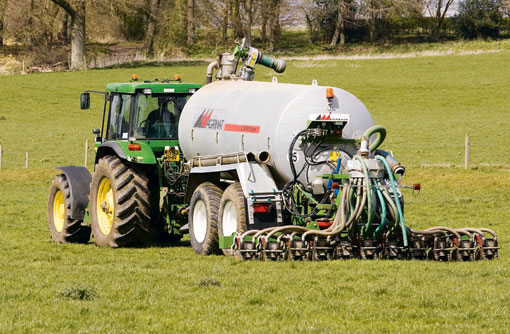Slurry bugs boost nutrient value

As fertiliser costs continue to rise, many dairy producers may be looking to make more from slurry.
And at Trebared Farm, Cardigan, inoculants have boosted the nutrient value of slurry so much there is no longer a requirement for bought-in fertiliser for some of their maize crop.
Dairy farmer David Phillips, who manages a 250-cow pedigree Holstein herd, says introducing a slurry booster and slurry bugs inoculation to the unit’s 500,000-gallon storage tank has contributed to fertiliser savings on his maize crop worth approximately £800 a year.
He says the slurry has been enhanced to the extent that he no longer needs to make artificial fertiliser applications to the 60-acre (24ha) crop that has been grown in the same field for 10 years.
“We used to apply 50kg/acre ammonium phosphate down the spout, and a further 50kg N an acre top dressing. However, after we started applying the inoculated slurry to the maize fields six years ago, we began to realise we were able to grow a high-quality maize crop without any purchased fertiliser,” he says.
“We initially did our own trials, and applied a portion of the area of maize sown without any fertiliser and found that yield was the same in the area treated. The results gave us the confidence to stop all fertiliser applications.”
Mr Phillips grows a late-maturing variety and the crop analysed 31.6% DM, ME 10.9MJ/kg DM and 68.4%D.
Pumping the slurry from the tank has also been made easier, he says. He used to clear the tank five times a year, but that was not a straightforward operation because of crusting and separation.
“We had the hassle of turning out the cows so we could lift up the slats to get in and agitate the slurry, a job that took five hours managed by one person before we even started spreading.”
“We’ve saved on labour and fuel and we now have a slurry that lends itself to injection – it’s consistent and in spreadable form. In addition, odour has been naturally reduced.”
David Phillips
Mr Phillips says since he first introduced the inoculant three years ago, agitation has been virtually eliminated, apart from a five-minute mix at the tank exit. “We’ve saved on labour and fuel and we now have a slurry that lends itself to injection – it’s consistent and in spreadable form. In addition, odour has been naturally reduced.
“Furthermore, we’re aware the bugs have helped to increase the slurry’s nitrogen content and we’ve made instant savings to the fertiliser bill; we’ve cut back on bagged nitrogen by 25 units N/acre across 200 acres of silage swards. Our silage analysis also says sugar content has consistently improved.”
Mr Phillips says he is now able to depend totally on nitrogen in the inoculated slurry applied to his 60-acre maize crop, and he is aware that it is helping to improve the soil’s residual N. “We take samples of soil for analysis and P and K indexes are being maintained at between two and three,” he says.
Overall, as well as the financial savings, he believes the improved slurry is encouraging better root development and a healthier plant. “This has to bode well for our farm’s overall sustainability,” he adds.
Livestock 2012
For more news and advice from Livestock 2012 see our dedicated page.
